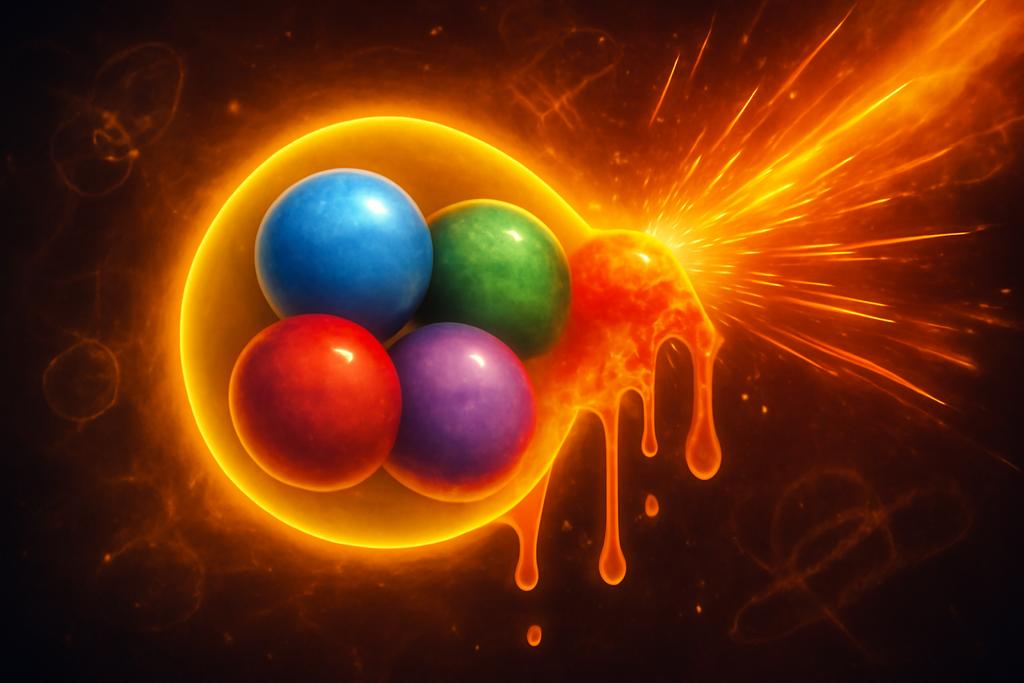The Curious Case of Tetraquarks
Imagine a particle so bizarre, so unexpected, it challenges our fundamental understanding of matter. That’s the world of tetraquarks—exotic particles made of four quarks bound together, rather than the usual two or three. Recently, scientists have been exploring these enigmatic entities, and a new study from researchers at the Instituto de Física Corpuscular (CSIC-UV), Thomas Jefferson National Accelerator Facility, and the Institute of Space Sciences (ICE, CSIC) offers a surprising twist: heat can melt them away.
Exotic Matter, Extreme Conditions
The focus of this research is on the Tcc(3875)+ and its heavy-quark spin partner, Tcc(4016)*+. These are particularly intriguing because they are close to the energy thresholds for other, more conventional particles, opening the door to interesting interactions. These interactions are not just theoretical curiosities; understanding them is crucial for advancing our knowledge of how particles behave in extreme conditions, like those found in the heart of particle collisions at places such as the Large Hadron Collider (LHC).
The researchers, led by Victor Montesinos, G. Montana, Miguel Albaladejo, J. Nieves, and L. Tolos, approached the problem using a sophisticated theoretical framework. They modeled the tetraquarks as bound states of other, simpler particles, and then calculated how these bound states would be affected by a hot bath of pions—essentially, a simulation of the high-temperature environment of a particle collision.
A Molecular Mystery
One of the most fascinating aspects of this research is the focus on the “molecular” nature of these tetraquarks. Think of it like this: a tetraquark isn’t necessarily a solid, indivisible lump; it might instead be more like a loosely bound cluster of smaller particles, a kind of subatomic molecule. The strength of this “molecular bond” is a key factor determining how the tetraquark behaves at high temperatures.
The study reveals a striking correlation: the more strongly the tetraquark resembles a molecule—the higher its “molecular probability”—the more dramatically its properties change with increasing temperature. At temperatures above 80 MeV (around 800 billion degrees Celsius!), the tetraquark essentially melts, its structure breaking down into its constituent particles. This is a remarkable demonstration of how a particle’s internal composition can influence its response to its environment.
Beyond the Melting Point
What does this mean? The implications are far-reaching. It suggests that the behavior of exotic particles in extreme conditions isn’t simply dictated by their mass and charge; it’s also profoundly shaped by their internal structure and the degree to which they resemble more familiar particles.
Furthermore, the study highlights the potential of future experiments to shed light on this molecular mystery. By carefully measuring the scattering amplitudes of particles within these hot environments, experimentalists could potentially gain unprecedented insight into the fundamental nature of these exotic states. Such measurements would act as a kind of litmus test for the internal structure of tetraquarks—a way to distinguish the tightly bound ‘compact’ tetraquarks from the more loosely bound ‘molecular’ tetraquarks.
Looking Ahead
The research underscores the importance of considering the subtleties of particle structure when studying exotic matter in extreme conditions. The fact that temperature can so dramatically alter the properties of these tetraquarks underscores the complexity of the strong nuclear force and its role in shaping the universe at its most fundamental level. This is not just about theoretical physics; it’s about developing a deeper understanding of the processes at play in some of the most energetic events in the cosmos.
This research opens up exciting avenues for future exploration, both theoretical and experimental. As our experimental techniques improve and our theoretical models become more sophisticated, we can expect an even richer understanding of tetraquarks and the strange and wonderful world of exotic matter. We are only beginning to unravel the mysteries hidden within these bizarre particles.










